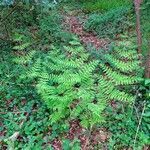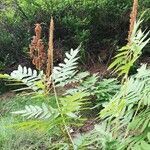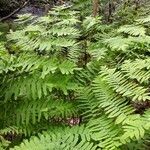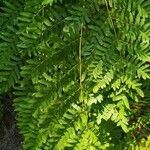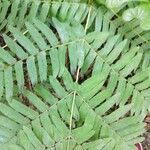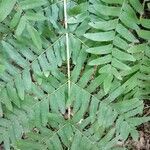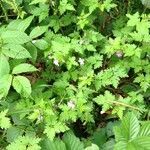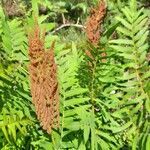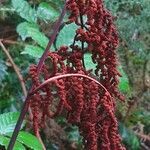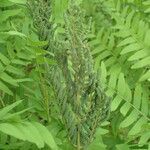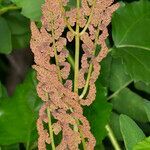Stems large, erect, up to 90 mm in diam., up to 200 mm tall, with persistent stipe bases and roots. Fronds caespitose, erect, up to 960 mm long, fertile fronds hemidimorphic, fertile pinnae apical. Stipe proximally laterally winged, terete higher up, up to 380 mm long and 6 mm in diam. Lamina 2-pinnate, oblong to narrowly ovate, up to 680 x 270 mm, with up to 11 pinna pairs. Pinnae 1-pinnate; sterile oblong-acuminate, up to 215 x 85 mm, with up to 11 pinnule pairs; fertile oblong-acuminate, up to 110 x 17 mm; petioles up to 7 mm long; with up to 11 pinnule pairs. Pinnules herbaceous, pale green, sessile; sterile oblong-acuminate to oblong-obtuse, up to 54 x 12 mm, minutely crenulate; fertile pinnules strongly contracted, linear to narrowly oblong, up to 27 x 4 mm; venation evident, pinnately branched, free. Sporangia borne at vein endings, short-stalked, capsule massive, globose, annulus poorly differentiated.
Lvs mostly 5–18 dm; petiole glabrous; blade bipinnate, broadly ovate, to 5.5 dm wide; pinnae 5–7 pairs, subopposite, the lowest slightly reduced; pinnules alternate, 7–10 to a side, oblong, to 7 × 2.3 cm, sessile or nearly so, rounded and oblique at the base, obtuse, serrulate, finely and closely veined; fertile pinnae borne at the ends of some of the blades, several pairs, the larger segments oblong, 6–11 × 2–3 mm, at first greenish, eventually brownish; 2n=44. Swamps and moist places, mostly in acid soil; circumboreal, in Amer. from Nf. to Sask., s. to Fla., Tex., and trop. Amer. Spring–early summer. The Amer. plant is var. spectabilis (Willd.) A. Gray.
Rhizome erect to suberect. Fronds tufted erect, with a rufous tomentum when young, becoming glabrous at maturity; lamina oblong to narrowly oblong, up to 1 m long, with subopposite pinnae, fertile pinnae borne in apical portion; sterile pinnules herbaceous to thinly coriaceous, very narrowly to narrowly oblong, up to 60 x 15 mm, unequally truncate basally, obtuse to broadly acute, minutely crenulate, petiolate except for adnate pinnules towards apices of pinnae; fertile pinnules linear, up to c. 25 x 2 mm, petiolate or adnate, bearing groups of sporangia at intervals.
Rhizomes forming thick erect trunks to 150 cm tall. Fronds 30-300 × 20-75 cm, ovate, 2-pinnate, glabrous except when very young, dimorphic with the outer ones sterile and inner fertile. Fertile fronds bearing sterile pinnae at base and much reduced fertile pinnae at apex. Sterile secondary pinnae in up to 15 pairs, 2-7 × 0.8-1.8 cm, narrowly oblong, obtuse, ± truncate at base, often with a rounded lobe on one side. Fertile secondary pinnae to 3 × 0.4 cm, densely covered with clusters of sporangia.
Terrestrial. Rhizome erect, up to 3 m long. Fronds erect, 2-pinnate, up to 1 m long, outline narrowly ovate, with dimorphic sterile and fertile pinnules; sterile pinnules narrowly ovate-oblong, glabrous at maturity; fertile pinnules much reduced, borne on terminal portion of lamina, covered in sporangia.
Rhizome erect, without scales, covered by a mass of persistent winged leaf bases. Fertile pinnules much narrower than sterile pinnules. Lamina 2-pinnate, up to 1 m long. Veins free. Sporangia borne in dense clusters on both surfaces of narrow fertile pinnules.
Sterile pinnules up to 6 x 1.5 cm., herbaceous to thinly coriaceous, very narrowly to narrowly oblong, unequally truncate at the base, obtuse to broadly acute, minutely crenulate, petiolate except for adnate pinnules towards the apices of the pinnae.
Perennial with erect rhizome. Fronds erect, stipe glabrous at maturity, lamina to 1 m, 2-pinnate Null Fertile pinnae borne in apical portion, sterile pinnules narrowly oblong, to 6 cm long, fertile pinnules with groups of sporangia.
A stout fern. It forms tufts. The fronds are erect and 2 m high. The frond stalk is 30 cm long and the blade 1 m long. It is oval in outline and twice divided.
Rhizome erect to suberect, covered with the persistent winged bases of the stipes, usually embedded in a mass of black fibrous roots and with tufted fronds.
Lamina 2-pinnate up to 1 m. long, with the fertile pinnae borne in the apical portion, oblong to narrowly oblong in outline, with subopposite pinnae.
Fertile pinnules up to c. 2.5 x 0.2 cm., linear, petiolate or adnate, bearing groups of sporangia at intervals.
Fronds erect, with a rufous tomentum when young, becoming glabrous at maturity.
